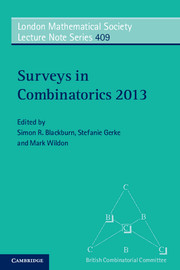Book contents
- Frontmatter
- Contents
- Preface
- 1 Graph removal lemmas
- 2 The geometry of covering codes: small complete caps and saturating sets in Galois spaces
- 3 Bent functions and their connections to combinatorics
- 4 The complexity of change
- 5 How symmetric can maps on surfaces be?
- 6 Some open problems on permutation patterns
- 7 The world of hereditary graph classes viewed through Truemper configurations
- 8 Structure in minor-closed classes of matroids
- 9 Automatic counting of tilings of skinny plane regions
- References
9 - Automatic counting of tilings of skinny plane regions
Published online by Cambridge University Press: 05 July 2013
- Frontmatter
- Contents
- Preface
- 1 Graph removal lemmas
- 2 The geometry of covering codes: small complete caps and saturating sets in Galois spaces
- 3 Bent functions and their connections to combinatorics
- 4 The complexity of change
- 5 How symmetric can maps on surfaces be?
- 6 Some open problems on permutation patterns
- 7 The world of hereditary graph classes viewed through Truemper configurations
- 8 Structure in minor-closed classes of matroids
- 9 Automatic counting of tilings of skinny plane regions
- References
Summary
Abstract
The deductive method ruled mathematics for the last 2500 years, now it is the turn of the inductive method. We make a start by using the C-finite ansatz to enumerate tilings of skinny place regions, inspired by a Mathematics Magazine Problem proposed by Donald Knuth.
Very important
This article is accompanied by the Maple packages
http://www.math.rutgers.edu/~zeilberg/tokhniot/RITSUF,
http://www.math.rutgers.edu/~zeilberg/tokhniot/RITSUFwt,
http://www.math.rutgers.edu/~zeilberg/tokhniot/ARGF,
to be described below. In fact, more accurately, this article accompanies these packages, written by DZ and the many output files, discovering and proving deep enumeration theorems, done by SBE, that are linked to from the webpage of this article: http://www.math.rutgers.edu/~zeilberg/mamarim/mamarimhtml/ritsuf.html.
How it all started: April 5, 2012
During one of the Rutgers University Experimental Mathematics Seminar dinners, the name of Don Knuth came up, and two of the participants, David Nacin, who was on sabbatical from William Patterson University, and first-year graduate student Patrick Devlin, mentioned that they recently solved a problem that Knuth proposed in Mathematics Magazine [5]. The problem was:
1868. Proposed by Donald E. Knuth, Stanford University, Stanford, California.
Let n ≥ 2 be an integer. Remove the central (n − 2)2 squares from an (n + 2) × (n + 2) array of squares. In how many ways can the remaining squares be covered with 4n dominoes?
- Type
- Chapter
- Information
- Surveys in Combinatorics 2013 , pp. 363 - 378Publisher: Cambridge University PressPrint publication year: 2013
References
- 1
- Cited by

